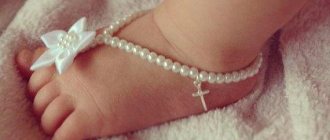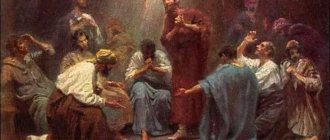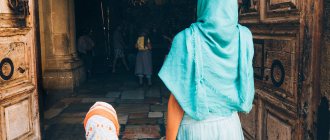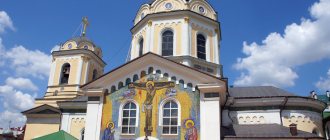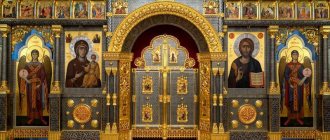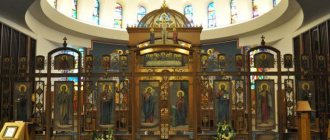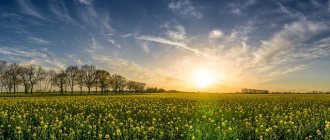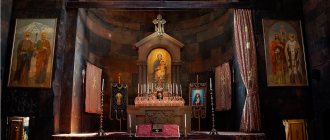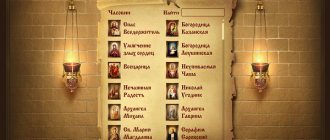Why can't you take pictures in a church?
Estimated reading time: less than a minute.
Reader question:
Why can't you take pictures in a church?
Answer:
You can often see signs on the doors of churches with the image of a crossed out camera. Visitors are perplexed - why can’t they take photographs in the church? A strict ban on photography (especially with flash) does exist in some temples and monasteries, but in most cases photography is possible. True, a number of conditions must be met.
If you are not sure that photography is welcome in a particular temple, it is better to clarify this point with its employees or priest. It is also necessary to remember that the temple is the house of God, and to behave reverently in it. You shouldn’t embarrass people praying by photographing them, don’t take pictures without a blessing at services and during the celebration of the Sacraments, and in order to capture interesting paintings or interiors, choose non-liturgical times.
The ban on filming in some churches is due to the fact that the flash can damage ancient icons and frescoes. “Photography as such does not harm works of art. The discussion is only about the use of flash. Although the pulse lasts a fraction of a second, the flash can damage the paint layer of ancient paintings. Therefore, in churches where vulnerable paintings are located, as in museums, the use of flash is prohibited. However, today’s technology allows you to take good photos without a flash: digital cameras can produce good images in low light,” explains Dmitry Trofimov, head of the Tsargrad creative workshops.
They are most strict about photography in monasteries, especially remote ones: often you can take pictures there only with the blessing of the abbot. This order was established so that the peace of the monastery and its inhabitants was not disturbed.
To summarize, we can say that globally the question “why can’t you take pictures in a church?” has not been staged for a long time: photography has firmly entered church life, just as electricity once entered it. Photographers are almost always present at especially solemn services, such as patriarchal ones. Many parishes also keep photo chronicles and post photo feeds from services on parish websites and social media pages. Often people do not have the opportunity to regularly visit the temple, make pilgrimages or attend solemn bishop services, and for them “church” photographs are a great joy and consolation. As a rule, parishioners are blessed with photo (as well as video) filming of events such as Baptism and Wedding.
By the way, there are many amateur and professional photographers among clergy and monastics. For example, you can read an interview with priest Andrei Rossanov, in which he talks about his path to photography.
Editorial staff of the magazine "Foma"
How to photograph an icon?
For competent attribution, it is good to stock up on high-quality photographs of the icon, especially if consultation with an expert is carried out in absentia and he can judge the condition and features of the icon only from the images. It seems like a fairly simple idea, obvious and boring in its banality. However, from time to time we receive murky, blurry photographs taken without any understanding of what the photographer was photographing and why.
To obtain a clear and understandable photograph of an icon, it is not necessary to use professional photographic equipment. Most modern simple cameras and mobile phones with built-in cameras have sufficient photography capabilities. The quality of the image depends on the skill of the photographer.
What photographs are needed to attribute and evaluate an icon?
In order for the expert to draw an adequate conclusion, it is advisable to take and provide for research the following photographs of the icon without frame:
• Full size icon with a clearly readable design.
Icon “Great Bishop - King by King” Wood, gesso, tempera. Late 19th century Photo of icons at home using an amateur digital camera. Sufficient level of quality for attribution and initial assessment of the icon.
• Close-up fragments of the icon – faces, hands, any interesting parts of the composition.
• If this is a hagiographic icon, it is good to separately present the marks, at least several.
• If there are attributed saints on the icon, it is also advisable to present them in a separate photograph quite large.
• If there is damage, loss, or any defects on the icon, it is advisable to accompany each serious or pronounced damage with a photograph and explanation.
Fragment of an icon. Damage, cracks, loss of paint and gesso, and dirt are visible.
• Photo of the reverse side of the icon.
Reverse side of an ancient icon. Damage from grinding beetles, traces of poor repairs, dirt and chipped wood are visible.
• If there are inscriptions on the back, it is advisable to photograph them separately so that they can be read. Dedication inscriptions often make it possible to trace the history of an icon and even identify its first owners. The historical significance of the former owners and the history of the icon can significantly affect the price.
• End sides of the icon. Photographs from this angle allow one to judge the degree of curvature of the icon. In some cases, the grain of the wood allows you to determine the specific type of wood used for the base.
A few words should be said separately about icons in frames. If you are confident in your accuracy and the ability to withdraw your salary yourself, you can try to do this. However, incorrect removal of the frame can damage the wood base of the icon, the paint layer and the frame itself. First, try to take photographs of the icon in its frame, and after receiving the first expert opinions on the value of the icon, decide whether to remove the frame. Salary removal may not be required to sell. (
How to photograph temples and in temples? Travel tips
On April 16, the Orthodox Church celebrates Easter. Regardless of your religion, in search of unusual and interesting stories for your photographs, be sure to visit a temple or church during the celebration.
NIKON D7100 / 12.0-28.0 mm f/4.0 SETTINGS: ISO 400, F4, 1/25 s, 18.0 mm equiv.
Religion is a huge layer of human culture. Many photographers often turn to religious subjects - take a look, for example, at the works of Sergei Maksimishin. This could be photography of church architecture, a report from a religious service, or portraits of church ministers and parishioners.
For photo travelers, religious sites and events are an essential part of another country's culture to explore. Moreover, working on religious topics, the photographer gets an excellent opportunity to talk about the traditions of the people, find new stories and textured subjects. Let's see what nuances are typical for photographing temples and religious events.
As a rule, the first encounter with the religious traditions of another country is an encounter with temple architecture. Grandiose cathedrals or small churches - it doesn’t matter, there can be a great many options, because even Christian churches are sometimes significantly different from each other. When photographing huge buildings close up, you will definitely encounter strong optical distortions: the structures will “collapse”, the vertical walls will seem to be tilted. This is the most common mistake when photographing architectural ensembles; to avoid it, you need to find a shooting point at some distance from the desired object.
While photographing the temples in the central square of Peruvian Cusco, for example, I climbed to an observation deck above the city. So I was able to capture the panorama of the city and the cathedrals built on the foundations of the palaces of the Inca Empire.
NIKON D7100 SETTINGS: ISO 100, F9, 1/200 sec, 123.0 mm equiv.
Nidaros Cathedral in Trondheim is built on the burial site of St. Olav, the first Christian king of Norway. I couldn't find a suitable vantage point to photograph the stunning facade of this temple, so I photographed the cathedral from the side of the church cemetery.
NIKON D7100 SETTINGS: ISO 100, F7.1, 1/250 sec, 33.0 mm equiv.
When it is difficult to choose a suitable point, it is not necessary to photograph the entire temple; you can capture its individual elements. For example, the façade of the Nidaros Cathedral is decorated with hundreds of sculptures—that’s what I noticed.
NIKON D5200 SETTINGS: ISO 100, F5.6, 1/125 sec, 170.0 mm equiv.
NIKON D5200 SETTINGS: ISO 100, F5.6, 1/200 s, 130.0 mm equiv.
While traveling around Australia we found ourselves at St Patrick's Cathedral in Melbourne. Just at that moment there was a wedding taking place there. The bride wore a stunning dress and I wanted to capture her in front of the huge cathedral. Therefore, instead of following the rules of architectural photography, I, on the contrary, decided to use geometric distortions as a visual means. Thanks to the ultra-wide-angle AF-S DX-NIKKOR 10-24mm f/3.5-4.5G ED lens, the walls of the cathedral “folded”, but this gave the structure an even greater scale. At the same time, the bride’s white dress contrasts perfectly with the grandiose dark walls.
NIKON D7100 SETTINGS: ISO 500, F4.5, 1/400 s, 15.0 mm equiv.
NIKON D7100 SETTINGS: ISO 500, F4.5, 1/500 sec, 15.0 mm equiv.
Inside churches, especially during services, it is very important to follow the rules of visiting. If photography is prohibited, you shouldn’t do it. If permission is received, try to film unnoticed by others. I use two techniques - shooting at a distance with a telephoto lens and long shots with ultra-wide-angle lenses.
A telephoto lens helps you pick out individuals from a crowd. For example, at the Western Wall in Jerusalem there are always many pilgrims and tourists. So I took a position in the distance and used the Nikon 70-200mm f/4G ED VR AF-S Nikkor lens to capture the amazingly different faces.
NIKON D7100 SETTINGS: ISO 400, F4, 1/250 sec, 225.0 mm equiv.
NIKON D7100 SETTINGS: ISO 400, F4, 1/100 sec, 300.0 mm eq.
Inside the Church of the Holy Sepulcher in Jerusalem, I used the AF-S DX-NIKKOR 10-24mm f/3.5-4.5G ED ultra-wide-angle lens. Thanks to this, I was able to take a photo of the Stone of Confirmation, with the shrine taking up most of the frame and the pilgrims in the background. If a lens with a long focal length was used, such a shot would not have been possible: a huge number of people in the temple blocked the view of the Stone.
NIKON D7100 SETTINGS: ISO 2000, F3.5, 1/30 sec, 15.0 mm equiv.
An ultra-wide-angle lens is also good because you can work with it in awkward positions without looking through the viewfinder, while still covering the entire room. For example, in a small Catholic church on the island of Taquile in Peru, I witnessed a very unusual scene. During Sunday's service, the congregation sang a song in Quechua, using the tune of the traditional El Condor Pasa tune (you've probably heard it performed by Simon & Garfunkel). A pianist and guitarist sat at the altar while the congregation sat on benches. In order not to disturb them by shooting in person, I carefully took pictures, holding the camera on my lap and turning on the quiet mode. From several takes, I was able to choose a good shot in which the child in the center of the photo is looking directly into the camera. By the way, to use quiet mode, select Q in the menu or on the shooting mode ring (the same place where continuous shooting is turned on). The mirror will remain in the closed position, which will help muffle camera noise when taking photos.
NIKON D7100 / Tokina AT-X 12-28 F4 PRO DX SETTINGS: ISO 400, F4, 1/13 sec, 21.0 mm equiv.
If you are shy about photographing strangers or there is no one in the temple, experiment with a partner. Try to catch the moment when a ray of light falls through the temple window. Ask your partner to position himself in this beam and you will get a great shot: such shots are much more interesting and “live” than just the interior of the temple.
NIKON D7100 / 70.0-200.0 mm f/4.0 SETTINGS: ISO 100, F4, 1/20 s, 123.0 mm equiv.
And when you are prohibited not only from taking photos, but also from entering, take pictures at the entrance, since this is also part of the local culture and your trip. For example, in Jerusalem, only Muslims are allowed to enter the Temple Mount. There are policemen at the entrance who maintain order and do not allow representatives of other faiths to enter. So I photographed these policemen, buried in their phones, in moments of relaxation among the ancient walls of Jerusalem.
NIKON D7100 SETTINGS: ISO 500, F3.5, 1/500 sec, 15.0 mm equiv.
As you can see, photographing religious sites is not difficult, even if you are in a completely different culture. Be careful and respect the people around you, their rituals and traditions. At the same time, remember that local residents are usually curious about visitors, are often happy to communicate and willingly talk about their national customs.

